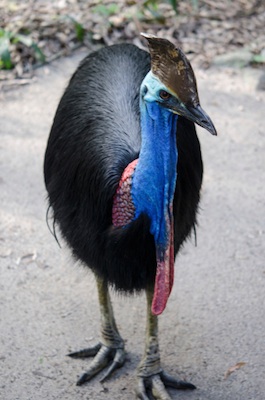The cassowary is a bird that does not fly.
Cassowaries live in rainforests.
Cassowaries eat fruit and seeds.
They have a helmet on their head.
They have feathers on their body and blue skin on the head and neck.
A flightless bird
The cassowary is a large flightless bird. It is the third largest of a family of birds called ratites. The ostrich is the largest ratite and the emu is second largest.
The ratites do not have a bone in their chest for flight muscles to anchor onto, so they cannot fly.
The cassowary is a flightless bird, the third largest flightless bird. Imaage©Getty Images
Habitat and Distribution (where they are found)
Their habitat is tropical rainforest. There are three kinds of cassowary, two found in New Guinea and one, the Southern Cassowary, found in northern Queensland in Australia.
Appearance
The cassowary has a casque on top of its head ©Getty Images
The cassowary has a horny helmet called a casque (say cask) , on its head. Some scientists believe that this helps it crash its way through the thick forest. It may also help the booming sound the bird makes echo more loudly through the thick forests where it lives.
The skin on the cassowary's head and neck is blue. Two long red flaps called wattles hang down from its neck.
Females are slightly larger than males. The feathers on the body are black and look more like hair than feathers.
The legs are thick and greyish, with three toes. The inner toe has a 12 cm claw like a spike, which is used in defence. Cassowaries can be dangerous when cornered.
The inner toe of each foot is armed with a sharp claw used in defence. ©Getty Images
Diet
Cassowaries eat fruit and seeds. The seeds pass through their bodies and are dropped in their poo far away from the trees they came from, and in this way the cassowary plays an important part in spreading seeds of rainforest plants.
They also eat small mammals and birds they find dead.
Life Cycle
The male cassowary raises the chicks ©iStock Images
Breeding takes place May to November. After mating, a female lays 3-6 eggs, then leaves the male to sit on them for about 8 weeks until they hatch.
The chicks are cream with brown stripes, and stay with the male for 9 months.
Conservation and Threats
The southern cassowary is classified as Endangered. There may be as few as 1500 left in the wild.
The reason for this is habitat loss. Much of the rainforest where they live has been cleared.
It’s a good idea to find information from more than one source!
Read about the three kinds of cassowary and watch a video about each of them
https://www.activewild.com/cassowary-facts/
Watch a video about tropical rainforests that shows why a cassowary is important to it:
https://thekidshouldseethis.com/post/rainforests-101




